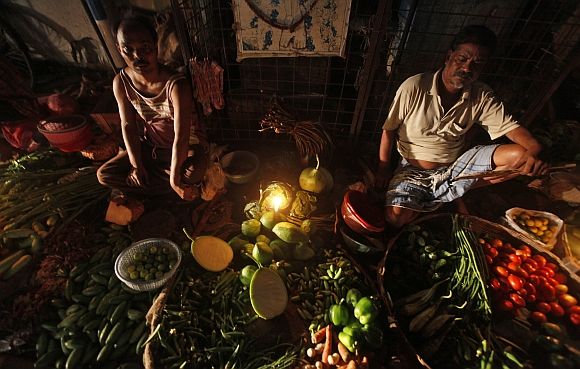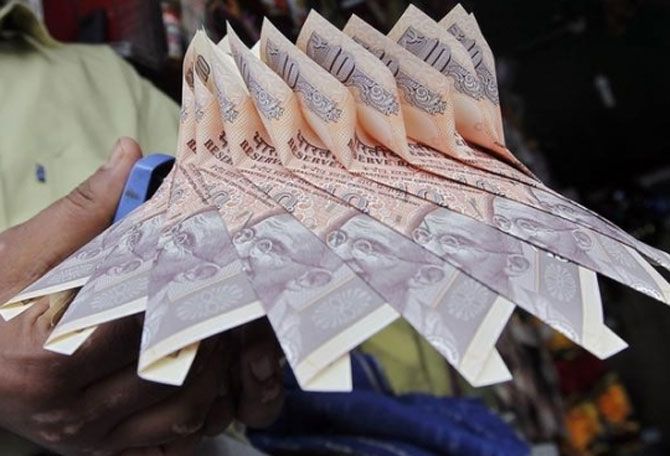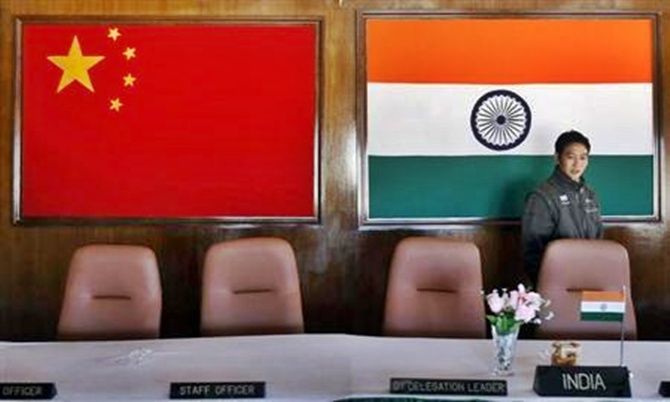
The biggest lesson China can teach India is that when it comes to sustaining a love affair with investors, nothing works better than an undervalued currency and its by-product: a current-account surplus, says Andy Mukherjee.
Prime Minister Narendra Modi's ‘Make in India’ campaign has won some early backers.
Japan has committed $34 billion of infrastructure and manufacturing investment over the next five years. Ahead of Chinese President Xi Jinping's visit this week, it has been reported that Beijing could pledge another $100 billion over a similar timeframe.
Assume that the United States, Britain and Germany come up with another $100 billion of investment proposals, and the Indian economy may have to soak up about 12 per cent of last year's gross domestic product (GDP) in overseas capital in the next five years.
This will present two challenges. One, the country has never had to deal with foreign direct investment (FDI) of this magnitude on a sustained basis. Two, the FDI won't come alone. More fickle - and potentially destabilising - foreign financial capital will follow close behind.
Digesting the windfall without unpleasant side effects will be tricky. Luckily for Mr Modi, China's own growth path provides a template for how best to absorb other people's money without ending up with an overheated economy or an overvalued currency.
Flows of FDI into China have averaged four per cent of GDP over the past 20 years. That's three times the rate in India.
To shore up its performance, New Delhi could learn five lessons from its northern neighbour.

Boost productivity
India's current working-age population of 800 million is the same as China's in 1993. And this labour pool will swell by 200 million by 2035, matching the demographic dividend that China has enjoyed over the past 20 years.
But while the lure of cheap labour will attract global manufacturing, Mr Modi can't take it for granted that India will supplant China as the world's factory.
Chinese wages are rising, but inexpensive labour in other populous nations will put up stiff competition. Japanese companies now rank Indonesia as the most attractive investment destination, ahead of India and Thailand.
Boosting productivity is, therefore, a top priority. In 1991, Indonesian workers were twice as efficient as their Chinese counterparts. Now, the Chinese are 1.6 times more productive. To replicate this success, Mr Modi needs to nudge investment into large coastal enclaves, like China's Pearl River Delta, and link them to the labour-surplus hinterland with high-speed trains.

Enforce contracts
But a "build and they will come" approach won't be enough.
India's power shortages and rickety transport infrastructure are only partly to blame for its underperformance in attracting inward investment.
What matters even more are issues like contract enforcement. On this measure, China ranks 19th in World Bank's annual "Doing Business" surveys, while India is stranded at 186th, just ahead of Angola.
Similarly, onerous Customs procedures in India cost almost twice as much as in China. This, too, hurts export-oriented manufacturing. If Mr Modi can bridge these critical gaps, India's ability to sustain overseas capital flows will get a boost.

Slay inflation
It will be equally important for India to tame galloping consumer prices, which hurt competitiveness by getting entrenched in wage expectations.
Already, the price level of household consumption in India is 1.5 times of what Chinese families faced when Beijing joined the World Trade Organisation in 2001. Allowing the rupee to strengthen against the dollar will reduce the prices of imported goods, but hurt Indian exporters in a fragile global economy.
It will be better to tackle inflation by replacing layers of sub-national taxes with a more efficient federal goods-and-services levy. Integrating India's fragmented food markets will also help. Once inflation is subdued, it will make sense for the central bank to target a somewhat undervalued exchange rate, and defend it with capital controls.

Run surpluses
The biggest lesson China can teach India is that when it comes to sustaining a love affair with investors, nothing works better than an undervalued currency and its by-product: a current-account surplus. In other words, India should be a net exporter of capital.
Conventional wisdom suggests the opposite: an economy with surplus labour should be able to offer outsized rewards to owners of capital.
That implies that India should import capital - by running a current-account deficit - rather than squirrel away the precious savings of its workers in United States Treasury bonds and other developed-world investments.
But the theory doesn't work well in practice. In the past 20 years, India has run an average current-account deficit of 1.3 per cent of GDP, while China has recorded an average annual surplus of 3.6 per cent.
By investing its surpluses in financial assets of rich countries, China has allowed the buyers of its products to enjoy low real interest rates. And that has enabled the West to import more. The additional demand has helped China to create more jobs. India could borrow a leaf from this playbook of mutual dependency.

Manage the politics
In a controversial 2003 paper, economists Michael Dooley, David Folkerts-Landau and Peter Garber described China's symbiotic relationship with the West as "the revived Bretton Woods" system of artificially fixed exchange rates. In a recent update, the researchers suggest the arrangement will continue even when India becomes the next China.
China's foreign-exchange reserves were $300 billion in 2003 - similar to India's reserves today. Since then, the Chinese war chest has grown to $4 trillion. If India pursues a similar model of export-led growth, rich nations will once again grumble about exchange-rate manipulation and job losses. Trade spats will escalate, and Mr Modi will have to work overtime to keep world markets open for Indian goods and services.
That will mean giving the rest of the world greater access to the wallets of Indian consumers. China started paying this admission fee starting with its World Trade Organization accession. India, which recently torpedoed a trade accord on standardised Customs rules, will need to do the same.
Domestic Indian businesses may be miffed if Mr Modi opens up protected industries - like retail, e-commerce and banking - too widely. Economic nationalism at home could emerge as a political obstacle.
International politics could be equally worrisome. World governments accommodated cheap Chinese labour into the global economy because they needed a disinflationary counterfoil to the wage-price spiral of the 1970s. But now the rich world is facing considerable disinflation because of insufficient demand.
Just how kindly the West will take to another huge labour-supply wave is not something Mr Xi can advise Mr Modi on. To gauge the extent of his diplomatic challenge, the prime minister will have to wait for "Make in India" to start bearing fruit. Friction will follow.
The writer is the Asia economics columnist at Reuters Breakingviews in Singapore. These views are his own.











